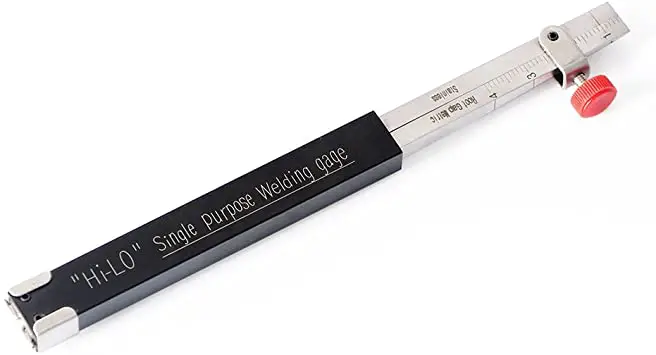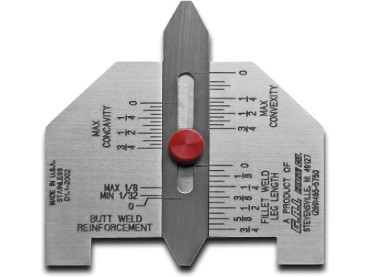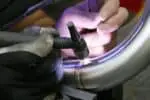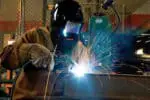In welding we often need to measure the correct size of the wire or sheet metal in order to set the amperage of the welder or to decide the position of welding.
That is when a wire gauge comes into use!
But that is not all, there are a lot more things that need to be inspected while welding like the fillet weld size, internal defects in the weld, etc.
And that is when a weld gauge comes into use!
Yes, in welding, a wire gauge is used to determine the diameter of the wires or sheet metal. The wire gauge has notches in it and each notch is marked with a specific wire size number. You need to pass the wire or sheet metal through a specific notch and that notch determines the diameter of the wire or the sheet metal. Whereas, a weld gauge is used to check the alignments, measure the porosity, check the dimension of the metal dimension as well as the weld dimensions.
In this article I will tell you about how to use a wire gauge for measuring diameters of wires and sheet metals, what is a weld gauge, the 7 different types of weld gauges and their uses and also some frequently asked questions regarding weld gauges.
So, let’s give it a quick start…
How to measure the diameter of wire using the wire gauge?
Measuring with the wire gauge is actually pretty simple! You just need to know the correct way of measuring which is as follows:
-
-
- Take the wire gauge and the wire cable.
- Try to select a notch in the wire gauge that is closest to the diameter of the wire cable.
- Pass the wire cable or the sheet metal through that particular notch
- If the wire passes too freely through that particular notch, then it means that the notch is bigger for the wire cable.
- Try to pass the wire through a smaller notch this time.
- If the wire passes considerably tight through the notch without bending its shape, then it’s the perfect notch for the wire.
- Mark the wire size number of that particular notch in the wire gauge and that is the diameter size of your wire cable.
-
A point to remember is that the sheet metal or the wire cable should not pass too freely or too tightly through the wire gauge notch!
What is a weld gauge?
Weld gauge is an inspection tool that is used by welders and welding inspectors to check the dimension of porosity in the weld, the weld dimension, dimension of the metal to be welded and also to check the alignment.
In simple terms, weld gauges are tools that help to inspect the size and shapes of the weld after the welding. They are usually metal plates that have cuts in them that corresponds to the cross-section of a particular type and the size of a weld.
Types of weld gauges and their uses
In general, there are 7 types of weld gauges which are as follows:
-
-
- The pipe internal alignment gauge
- The single-purpose weld gauge
- Adjustable fillet weld gauge
- Bridge cam gauge
- Visual weld acceptance criteria gauge
- Automatic weld size gauge
-
Now, let us have a look at their uses:
1.) The pipe internal alignment gauge:
These gauges are used to measure the internal alignments of the pipes after they have been fit. They are also used to measure the internal misalignment of the pipe walls before and after.
Also, they are used to measure the crown height, weld fillet size and the scribe lines. All in all, they help to reduce the numbers of radiographic defects.
2.) The single-purpose weld gauge:
There are 2 types of single-purpose weld gauges, wherein one is used to check the internal alignment and the other is used to determine the weld root spacing.
3.) Adjustable fillet weld gauge:
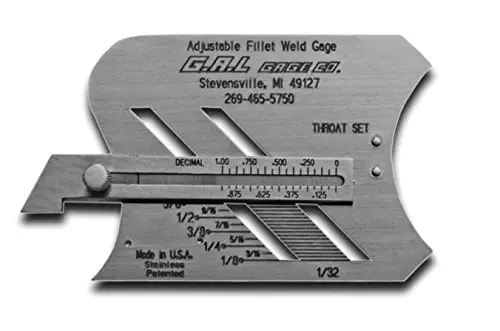 It is used to measure any fillet weld from 1/8” to 1” thickness, and also measures the weld throat thickness.
It is used to measure any fillet weld from 1/8” to 1” thickness, and also measures the weld throat thickness.
4.) Bridge cam gauge:
It is used to inspect the welded surfaces and joints and is also used to measure the excess weld metal, fillet weld throat size, fillet leg length, depth of undercut, misalignment, dept of pitting, angle of preparation from 0 to 60 degrees, etc.
5.) Visual weld acceptance criteria gauge:
This is used to determine whether a particular fillet weld has met the US NRC visual weld acceptance criteria for structural weldments, where NRC stands for Nuclear Regulatory Commission.
The 4 essential measurements required for the criteria are: porosity comparison, undercut depth, amount of porosity per linear inch, and the crown height.
6.) Automatic weld size gauge:
This type of gauge is used to provide the accurate calibrations of fillet welds and butt-joints.
What is the Universal welding gauge WG9?
The universal welding gauge WG9 is made of stainless steel and it contains of 2 parts: plate 1 with a window for reading and plate 2 which is movable and had 3 non-linear scales and measuring circuits. It is used to leg fillet weld and the joint height in fillet weld.
How is a fillet gauge used in welding?
A fillet weld gauge is often called by tempilstick. In welding, a fillet weld gauge is used to verify whether the size of the welded metal frames have matched with that of the one in the blueprint.
But there is a limitation to it and that is the fillet gauge might not be able to deliver the exact size of the metal sheets in inches. However, an estimation of the size of the metal frame can be gathered for reference.
Which is the best way to weld 20-gauge sheet metal?
The best and perhaps the most effective way to weld a 20-gauge sheet metal is MIG (metal inert gas) welding. In this welding process a wire electrode is fed through a welding gun and the electric arc produced melts the electrode and it is subsequently deposited at the joints of the metals to be welded.
Let’s call it a day!
Be it at the beginning of welding or be it at the end, a wire gauge and a weld gauge is of utmost necessity to measure the thickness of the metal and that of the welded frame to know if the desired measurement has been achieved.
That’s all with wire gauges and weld gauges today!
Will be back soon with another informative post. Till then…
Have a great welding day!


